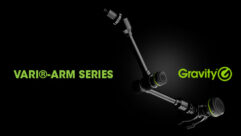
The AV Gravity of Gravity
Oct 21, 2013 11:33 AM,
By Jason Bovberg

I’ve spent more money on Alfonso Cuaron’s Gravity than I’ve spent on any other movie in my life. I didn’t plan it that way. It just so happens that this film is ideally suited to the most expensive film-exhibition methods known today. This is a movie—based on reports I was hearing out of film festivals—that I wanted to see on the biggest screen with the biggest sound. While watching it for the second time, I realized that this is the way movie theaters are going to compete with the rising trends of home theater and digital video subscriptions services such as Netflix: Go bigger.
My first experience with Gravity was at an IMAX 3D auditorium in Las Vegas. I plunked down $19, took my seat, and proceeded to have my eyeballs and ears pummeled. IMAX is known for its ultra-high-resolution photography, and even though longer Hollywood productions play at a slightly lower resolution on the gargantuan IMAX screen to allow for running time, the image was immersive and vivid. That’s exactly what I wanted—to experience the film the way the director intended: huge and bright.
I wouldn’t say the experience disappointed, exactly. The movie is brilliant, suffice it to say. This isn’t a movie review, but rather some musings about the experience. And as experiences go, this was a stunner. I felt as if I was floating in space along with the characters. I felt as if the movie was everywhere I looked. But I was left with the nagging feeling that it was too big. Whenever I visit an IMAX auditorium, I always feel as if I’m sitting in the front row—even if I’m in an ideal seat in the middle, and toward the rear. The image is overwhelming. I know that’s the way it’s supposed to be, and there’s a benefit to it, but I feel myself pulling my head back and swiveling my head a bit too much to be able to see the entire image.
The end result was that I felt as if I had seen Gravity in its ideal presentation, but there was something just short of perfection.

A week later, I had an opportunity to see the film in an AMC Enhanced Theater Experience (ETX) auditorium in Denver, and I was treated to another top-tier presentation—immersive, loud, precise, mesmerizing. It cost another $15 for me, as well as another $40 for the rest of the family. But it was worth it! It afforded me an excellent opportunity to compare possibly the two highest-end film-exhibition scenarios that are currently available and see what they offer above and beyond home theater.
Whereas IMAX 3D provided a huge, loud experience, the AMC ETX presentation was a smaller—perhaps more sane—image size that was easier to wrap my head around, although it didn’t provide the same brightness and resolution. Also, the large, comfortable IMAX 3D glasses are inherently easier on the eyes than the smaller Real3D variety. Where the ETX presentation trumps IMAX, though, is in the sound presentation, which is a Dolby Atmos powerhouse. Dolby Atmos supports up to 128 discrete audio tracks and as many as 64 unique speaker feeds, and at our auditorium, those speakers lined not only the sides and rear of the house but also the ceiling. Aural panning is more prices than I’ve ever heard at any theater, and—again—Gravity is a particular beast for this kind of swirling audio.
In the end, the two presentations of Gravity offered excellent AV experiences, but at high cost. And I was glad to pay it! I had minor quibbles about each, but I loved the ability to compare what each does right. I appreciated the assigned seating at the ETX theater, as well as the roomy stadium configuration. My family luxuriated in the plush recliners. Earlier, I marveled over the vastness of the IMAX screen, and the chest-thunder of the audio. And I love the sense of technical one-upsmanship inherent in the dueling presentations: the notion that technology innovation and evolution is still happening at the movies.
I’ve paid close to $80 for this film, and I’ve barely thought anything of it. I’m sure many other people have paid a premium for Gravity thanks to the necessity that it be viewed in optimum conditions. Box office receipts attest to that. According to reports, roughly 80 percent of viewers are choosing IMAX 3D for the experience. Much of this movie’s success, therefore, is thanks to the higher ticket prices associated with these “big” venues.
This is how movie theaters are going to survive!
But what are the repercussions for home theater? It’s hard to imagine Dolby Atmos, with its many discrete audio channels and huge power demands necessitating the placement of more than a dozen speakers, taking off at home. It’s also hard to imagine home theaters of the future going much larger than today’s norms: IMAX will never go mainstream in the connected home.
These are vital differentiators between movie theaters and home theaters.
The increasing rise of high-end theater technologies such as IMAX 3D and AMC ETX is a promising trend in the age of digital downloads and tablet viewing. Whereas the world of music seems to be moving to smaller and lower-resolution—with its larger and more high-resolution formats relegated to a niche audience—the world of the movies is retaining its higher-end experience.
I’ve used that word “experience” often in this article and for good reason. I think what we’ll see increasingly as we move forward with film exhibition is movies as events. In order for movie theaters to thrive in a time when consumers prefer to stay at home with their own AV setups or even their tablets, they need to invest in technologies that can’t be duplicated. They can’t just cheat with fake IMAX or sloppy, upconverted 3D, which in the past have enraged consumers, who feel cheated by paying high ticket prices for half measures.
Movie theaters still have a place in our home theater and digital download lives. But they need to devote the best resources and pay top prices to create an experience that consumers can get nowhere else. They need to be precise and powerful, not gimmicky and expensive for no reason. I love my home theater—and, yes, my tablet, even for occasional movie watching—but nothing will ever replace the movie-going event. The studios and exhibitors need to keep that in mind, and keep the movie theater sacred and, above all, special.










